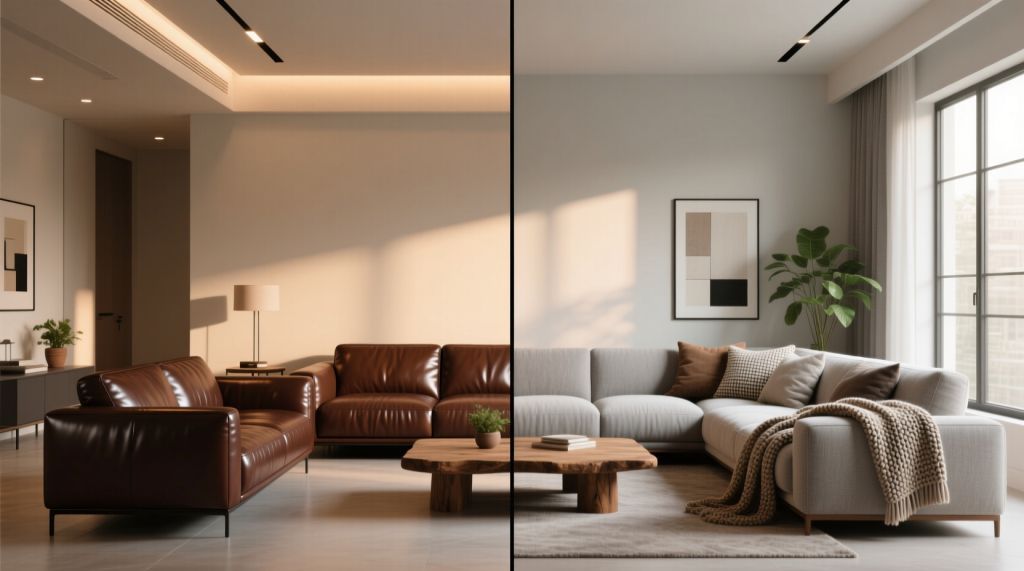The sofa is the heartbeat of your living room—where conversations linger, kids sprawl, and pets rule. Choosing between leather and fabric goes beyond aesthetics; it’s about surviving daily chaos while matching your vibe. Leather offers refined toughness; fabric delivers plush adaptability. This guide cuts through retailer gloss to reveal genuine durability, hidden expenses, and care demands. When cushions deflate, seams tear, or stains settle in, experienced sofa upholstery services can often revive either material for a fraction of a new sofa’s price tag.
Quick snapshot
- Leather: scratch-resistant hide, wipe-clean surface, gains vintage charm. Premium upfront cost.
- Fabric: year-round softness, endless styles, budget tiers. Requires consistent upkeep.
Let’s explore each material’s core strengths, pitfalls, and real-world performance.
Leather — the facts
Pros
- Durability. Full-grain leather endures decades of friction—belt buckles, laptop edges, constant sliding—without fraying or pilling.
- Easy to clean. Liquids bead on sealed surfaces; a microfiber cloth and mild soap erase most mishaps in seconds.
- Aging. Quality hides soften into a unique patina—think a cherished leather wallet that improves with every use.
- Hypoallergenic. Non-porous leather repels dust mites, pet dander, and pollen, easing allergy flare-ups.
Cons
- Temperature sensitivity. Leather chills in winter drafts and clings in humid heat, shifting comfort with the seasons.
- Price. Genuine leather runs 40–65% above comparable fabric models; bonded versions save money but peel prematurely.
- Visible damage. Scratches etch permanently, especially on lighter or unprotected finishes.
- Color and texture limits. Solid hues dominate; woven patterns, florals, or mixed textures aren’t feasible.
What to expect: Leather suits sleek urban lofts, home offices, or formal lounges. It resists odors and embedded fur. However, enthusiastic pets or pocketed keys leave lasting marks. Minor scuffs sometimes buff out with conditioner, but deep cuts or cracked panels require professional patching via sofa upholstery services.
Fabric — the facts
Pros
- Variety. From bouclé to canvas, herringbone to velvet, the options span every aesthetic and era.
- Comfort. Fabric maintains consistent softness year-round—no icy shock or sticky adhesion.
- Cost range. Entry-level blends start under $680; high-performance lines exceed $4,100 yet rival leather durability.
- Design freedom. Custom piping, tufting, or modular sections allow seasonal personality shifts.
Cons
- Stains and wear. Untreated textiles absorb spills instantly; high-traffic zones flatten, pill, or shine with body oils.
- Cleaning needs. Fabric codes (W, WS, S, X) dictate safe methods; mistakes create rings, shrinkage, or fading.
- Allergens. Fibers trap dander and dust unless vacuumed weekly and deep-cleaned annually.
- Fading. UV exposure bleaches dyes unevenly, especially near large windows or patio doors.
What to expect: Fabric sofas invite lounging, pillow forts, and family movie nights. They thrive in eclectic, lived-in spaces. Performance fabrics like Crypton or Microban mimic natural textures while repelling liquids. When a single cushion sags or an arm frays, targeted re-covering through sofa upholstery services restores balance for 25–40% of replacement cost.
Cost and lifespan
Leather ranges $2,100–$5,400 for quality pieces. Fabric spans $660–$3,800. Longevity favors leather: 19–29 years versus 6–16 for mid-tier textiles. Nanotreated fabrics now reach 17–23 years, narrowing the gap.
Annualize total ownership. Include $65–$85 yearly conditioning for leather, $175–$255 professional fabric cleanings, and repair reserves. A $3,900 leather sofa lasting 26 years equals $150/year; two $1,950 fabric replacements in the same period total $150/year plus landfill fees.
Maintenance and real-world care
Leather: Dust weekly, condition every 6–11 months, blot spills instantly. Avoid harsh cleaners—they strip protective topcoats. Fabric: Vacuum crevices with brush attachments, rotate cushions biweekly, treat spots within the hour using coded solutions.
Frame fatigue, collapsed springs, or shredded foam don’t require full replacement. Sofa upholstery services specialize in surgical fixes—new webbing, spring reties, high-density foam cores. Clients often extend usable life 10–15 years for 20–35% of a new sofa’s cost.
Family life and pets
Daily chaos demands strategic materials.
- Young families: Mid-tone performance fabrics with soil-repellent coatings hide fingerprints, juice drips, and crayon streaks.
- Pet households: Leather vacuums fur easily but scars from claws; tight-weave pet-grade textiles endure digging and drool.
- Light-use adults: Leather’s minimal dusting fits vacation homes or formal parlors.
Style and resale value
Leather conveys quiet luxury—perfect for monochromatic palettes or leather-trimmed studies. Fabric enables trend play: swap throw pillows to refresh without reupholstering. Neutral tones in either material photograph cleanly for listings; neon teal or butterscotch leather narrows buyer pools.
Environmental and ethical notes
Traditional tanning consumes water and chromium; responsible tanneries now recycle effluents and use plant-based dyes. Vegan leathers (pineapple, cork, or recycled PET) mimic aesthetics but vary in breathability. Fabric footprints range from regenerative wool to petroleum-based polyester. Lifecycle analysis favors durable choices over frequent replacements.
Final recommendations
Choose leather for heirloom resilience, wipe-and-go ease, and allergy-friendly surfaces. Select fabric for tactile warmth, infinite customization, and budget elasticity.
Test finalists for 20 minutes minimum. Probe frame construction (kiln-dried hardwood vs. engineered wood), foam density (2.0+ lbs for longevity), and suspension (eight-way hand-tied springs outperform sinuous wire). Local Singapore sofa upholstery services offer free longevity assessments—tap their expertise before committing. The ideal sofa should feel like an extension of your rhythm, not a daily negotiation.
